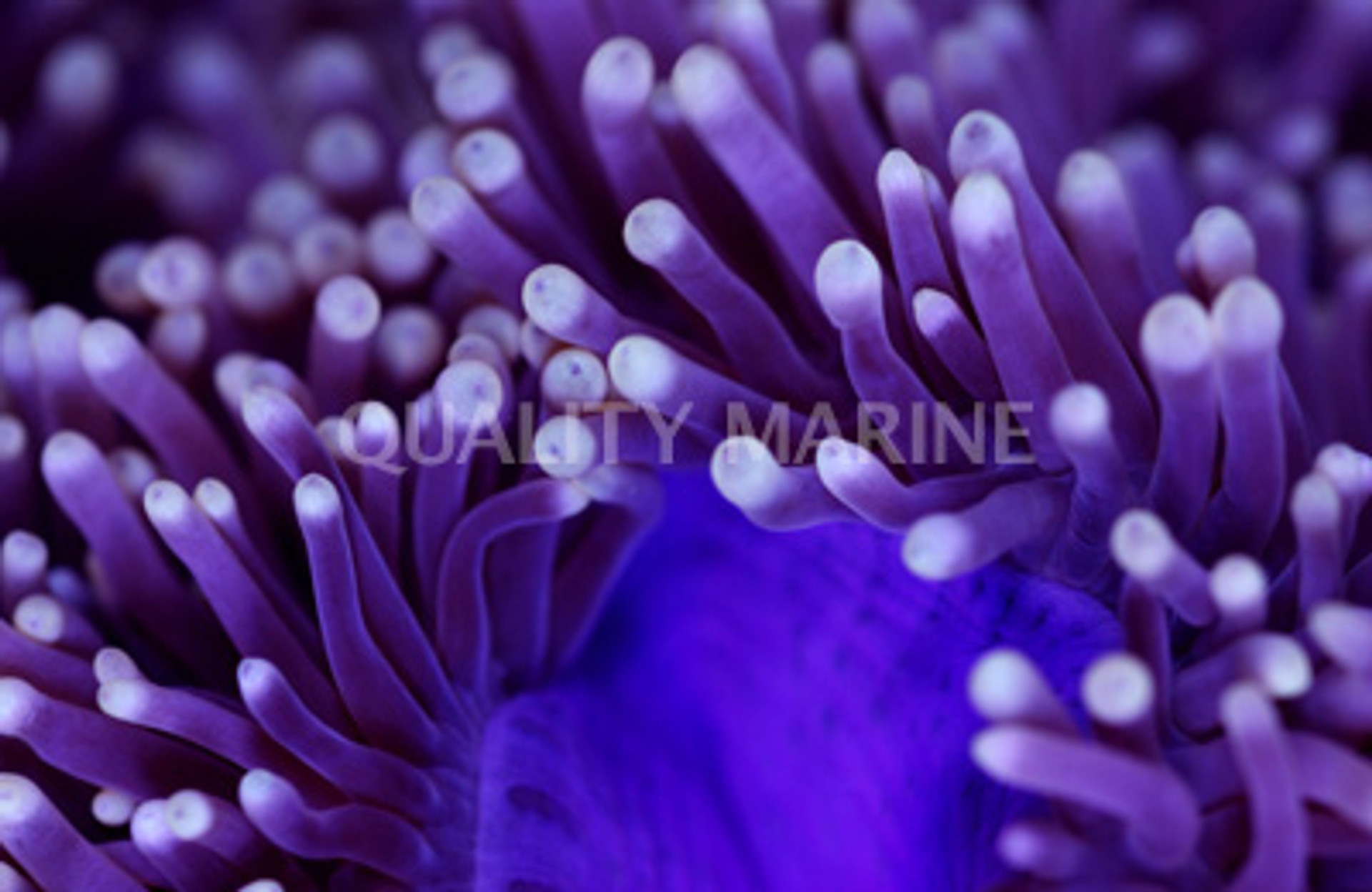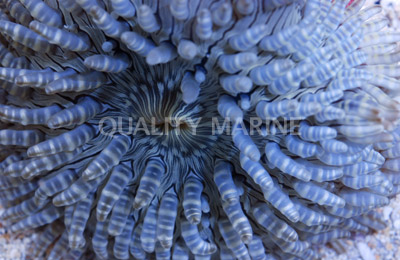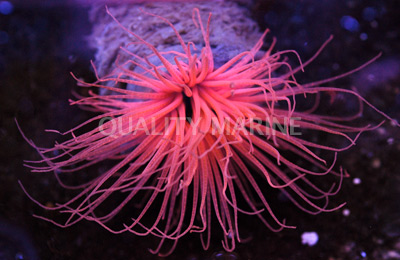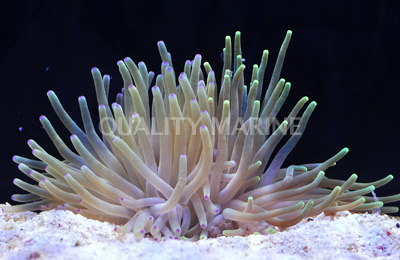Rock Anemones vs. Sand Anemones

When it comes to the successful aquarium husbandry of sea anemones, one of the most important considerations is where to place a specimen. Most species benefit from strong lighting, so you might be tempted to stick an anemone as high up on the rocks as possible, allowing it to soak up the sun. This is all well and good for a species like the Magnificent Sea Anemone, which naturally occurs at the top of the reef, but this would also make for a miserable experience for a Long Tentacle Anemone.
To understand why this is, one has to understand just what it is that these anemones are doing out in the wild. Every species has its own unique ecological specialization, and these have to be taken into account when deciding on which species to add to an aquarium. If you have a bare spot in the rocks in mind, then you dont want a species that favors a sandy substrate. And the opposite holds true, with species originating from reef environments needing a firm bottom to hold tight to. So let's take a brief moment to explore these two differing lifestyles found among among our tentacled friends.
Rock-dwellers
Magnificent Sea Anemone (Heteractis magnifica): The quintessential reef-associated sea anemone is the colorful H. magnifica. This species sits high on the reef, often in surprisingly shallow waters, allowing itself to be exposed to the strongest light and heaviest surge. In an aquarium, this is the anemone most likely to move itself around as it searches for the spot that best meets its needs. In dimly lit, low flow systems, this search is often endless and fruitless, and such unfortunate specimens often perish before long, often at the hands of a nearby powerhead or overflow. In favorable habitats, H. magnifica can be an ecologically dominant species, occupying large expanses of the reef in a dense, clonal colony.

Heteractis magnifica
Bubbletip Anemone (Entacmaea quadricolor): The ubiquitous Bubbletip Anemone is probably the species most commonly kept in captivity, and its often the species aquarists have the greatest success with. This is another typical reef dweller, but, unlike with the Magnificent Sea Anemone, Entacmaea prefers to inhabit more secluded corners. The typical Bubbletip habitat is a shallow, brightly lit lagoon full of the branching yellow Porites cylindrica, and its between the branches of this coral that this anemone can be found occurring in vast colonies. Its not uncommon to see thousands in a small area, usually accompanied by a great many tomato clowns. Colonies like this are generally home to small specimens, usually not much larger than a grapefruit, but theres a much larger form that this species is known to take, usually in deeper reef habitats. This is also where we usually encounter the other anemonefish that specializes in Entacmaea, the Maroon Clown.

Entacmaea quadricolor
In captivity, its best to tuck the foot of a Bubbletip into some crevice within the live rock, somewhere that will provide it with good flow and light... and then hope it doesnt move about too much.
Carpet Anemones (Stichodactyla mertensii & Stichodactyla tapetum): Carpet anemones are a mixed bag. There are species found mostly buried in sand, and there are others found only on rocks. Of the latter, the Maxi Mini Carpet (S. tapetum) is most characteristic. This species is unlike anything else in its genus, growing to only a few inches across, featuring short, stubby tentacles, mottled in color, and without any bumps (verrucae) on its body column. Its also the only Stichodactyla which doesnt host clownfish, and theres actually been very little (i.e. no) research done to prove that it actually belongs within this genus. It behaves more like a mushroom coral than most other anemones, clinging tight to the reef and rarely moving about.
On the other hand, theres Stichodactyla mertensii, the only large carpet anemone found in reef habitats. It is often confused with the other large species from this genus, but its floppy appearance (often seen loosely draped over rocks), relatively long tentacles, and its red-spotted column allow it to be identified. Nearly all specimens are brown (which naturally makes this a less-popular offering), but the rarely seen red morph is highly valued. Unfortunately, large carpet anemones like this have a nasty habit of snacking upon their tankmates (at least, those which arent from the genus Amphiprion).

Stichodactyla sp.
Feather Carpet Anemones (Thalassianthus): The so-called Feather Carpets of the family Thalassianthidae are a small group that can be easily confused with the true Stichodactyla carpets. Both groups have an oral disk covered in tentacles (generally an uncommon feature for an anemone to possess), but these differ in having their tentacles branched (i.e. feathery). They also possess some peculiarly modified structures around the edge of their oral disk known as nematospheres, which resemble a cluster of grapes and are often of a contrasting color. Of the half-dozen species in this family, all occur on rocky substrates. Some, like the Pizza Anemone (Cryptodendrum adhaesivum) and Hemprichs Anemone (Thalassianthus hemprichii), are more typical of true coral reefs, while other species of Thalassianthus (e.g. T. aster, T. dendrophora) tend to be found in marginal habitats laden with silt.
Sand-dwellers
Long Tentacle Anemone (Macrodactyla doreensis): The bright colors of the Long Tentacle Anemone make it a favorite of aquarists, but this is one species that likes to bury itself deeply into soft sands. A substrate several inches deep is a requirement to keep this species happy, along with enough light to reach to the bottom of its aquarium. Without these needs being met, Macrodactyla can fail to thrive. In the wild, the typical habitat for this species is a sandy lagoon full of Halimeda algae, sometimes within intertidal depths, but also as deep as 30 meters on sandy slopes. Amphiprion clarkii makes use of this species, but it is otherwise fairly unpopular among clownfishes. Note that this species is often confused with other similar-looking anemones, like the Bubbletip and Sebae, but is easily identified by its colorful, bumpy body column.

Macrodactyla doreensis
Beaded Anemone (Heteractis aurora) & Sand Anemone (Heteractis malu): The peculiar tentacle shape of the Beaded Anemone makes it one of the more unmistakable anemone species of the Indo-Pacific. This is another specialist in sandy habitats, typically found with its oral disk held flush against the substrate. On occasion it can also be found in areas of loose rubble, positioned between the broken bits of rock, though such specimens are often more contorted in appearance and generally seem less healthy than those from sand flats. An aquarium with plenty of room on the bottom, a layer of fine substrate, and relatively low water flow is ideal for this one. Saddleback and Clarki Clowns are the natural choice. Another ecologically similar species is the uncommonly seen Sand Anemone (H. malu). Its appearance feels like a cross between H. aurora and H. crispa, with short, smooth tentacles sparsely set across the oral disk.

Heteractis aurora
Carpet Anemones (Stichodactyla haddoni & Stichodactyla gigantea): This pair of carpet anemones are typical of shallow sandy environments, often occurring in great abundance in intertidal mud flats. Its not uncommon to see these exposed at low tide, transformed into an amorphous heap of floppy, slimy tentacles. The Giant Carpet Anemone is not notably larger than others in its genus, and the common name merely stems from its scientific name. When it was described in the 18th century, it was certainly larger than other anemones known at the time. The species is most often mistaken for the reef-dwelling S. mertensii, but youll only ever find S. gigantea in the shallows, buried in sand. It tends to twitch its tentacles around, for reasons unknown. Stichodactyla haddoni is often referred to as the Saddle Anemone, alluding to the strong saddlelike undulations of the oral disk. Its tentacles are unique within the genus for their blunt tips. Unlike S. gigantea, this one occurs both in the shallows and as far down as 30 meters, and it can sometimes be found around loose rubble, though it tends to be far more common in sand and silt.
Tube Anemone (Cerianthidae): Ceriantharia is a distinctive order of coral, every bit as different from a sea anemone as it is from a zoantharian or a mushroom coral or a black coral. Internally, these two anemones are vastly different in their morphology and have their own distinctive juvenile stages. Tube anemones reside within a mucusy tube formed from the threads of their highly modified stinging cells. They combine these with the surrounding silts and, voila!, a tube is formed. Most shallow species are found in silty lagoons, poking straight up from the bottom. The species most common in the aquarium trade are those from the sands of proper coral reefs. Tentatively identified as Pachycerianthus magnus, this species is highly variable in coloration, often with pink or purple marginal tentacles or with green oral tentacles or both or neither. Sometimes this species is all black. While it can be propped up inside of live rock, the better placement for a tube anemone is within a deep layer of sand. And unlike the other species discussed here, this one is not photosynthetic and must be fed. Small fishes have to be wary of tube anemones, making this a bit of a poor choice for most reef aquariums.

Cerianthidae
Generalists
Sebae Anemone (Heteractis crispa): Youll sometimes see this species referred to as the Leathery Anemone, in reference to the thickened texture of the body column, while the name Sebae refers to the 17th century naturalist who first illustrated it, Albertus Seba. This is the only large Indo-Pacific anemone that hasnt specialized in any particular niche. It occurs on coral reefs, but youll find it both within the rocks and buried in the sands just below the reef. But unlike some of the true sand specialists we just met, Heteractis crispa is generally in close proximity to coral-rich habitats. As such, this is one of the easier species to keep in an aquarium, accommodating itself to a wide range of conditions. Smaller specimens look a bit like a Bubbletip, with short, stout tentacles, usually lightly colored and having a purple tip, while mature specimens are dramatic in their appearance, full of innumerable long tentacles swaying gracefully in the currents.
Rock Flower Anemone (Phymanthus crucifer) & Giant Caribbean Anemone (Condylactis gigantea): These two common Caribbean species might look very different, but they behave more or less the same on the reef. Both can be found nestled deep within the reef itself or buried in the sand. Likewise, these species can be placed just about anywhere within an aquarium. In recent years, the Rock Flower Anemone has become enormously popular owing to the many vibrant color combinations it comes in. Most aquarists choose to place them directly on the sand bed, and its not uncommon to see aquariums whose floorspace is entirely taken up by a rainbow of different color morphs. Condylactis can be a bit more troublesome. Its tall body, long tentacles, and stark white color certainly make for a striking aquarium inhabitant, but its tendency to move around can cause serious trouble if it gets too close to a neighboring coral. For this reason, relatively few reef aquarists bother with this anemone, and it often gets used as an inexpensive addition to otherwise fish-only systems. Note that while clownfish will sometimes make use of this species, this pairing is often not successful.

Condylactis gigantea